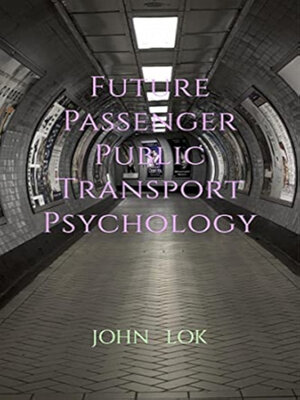
Sign up to save your library
With an OverDrive account, you can save your favorite libraries for at-a-glance information about availability. Find out more about OverDrive accounts.
Find this title in Libby, the library reading app by OverDrive.



Search for a digital library with this title
Title found at these libraries:
| Library Name | Distance |
|---|---|
| Loading... |
Behavioral Economic Theory Explains Passenger Behavior
MY perspective, rooted in behavioral economics, offers insights into various aspects of passenger behavior within the context of future public transport. His work emphasizes how economic and technological shifts influence consumer choices and psychological needs in transportation.
Factors Influencing MTR Underground Train Transportation Passenger Behavior
Behavioral economic theory posits that human decision-making is not always rational and is often influenced by psychological, social, and emotional factors My research specifically explores how economic changing environments influence consumer behaviors, including those of public transport passengers .This framework suggests that passenger behavior is shaped by perceived value, comfort, convenience, and environmental concerns, rather than solely by cost or speed . For instance, the desire to reduce air pollution and enhance individual comfort drives the consideration of electric, non-manual driving cars, reflecting a shift in consumer priorities beyond mere efficiency .
Passenger behavior in MTR (Mass Transit Railway) underground train transportation is influenced by several factors. These include reliability, frequency, safety, and the overall comfort of the journey [4]. From a behavioral economics standpoint, passengers weigh the perceived benefits of speed and efficiency against potential discomforts like crowding or lack of personal space [1]. The integration of AI and machine learning could potentially analyze new "intake" behavioral variables, such as how passengers respond to automated systems or personalized service, thereby influencing their choice of MTR over other modes . The perceived safety of AI non-manual driving systems, for example, could significantly impact passenger confidence and ridership .
Psychological Need Differences Between Rail and Bus Passengers
Future Human Transport Need Change
Psychological needs differ between rail and bus passengers due to varying travel experiences and expectations. Rail passengers, particularly on underground systems like MTR, often prioritize speed, punctuality, and a relatively smooth journey, especially for longer commutes .The enclosed environment of a train might also lead to a greater emphasis on personal space and quietude . In contrast, bus passengers might prioritize accessibility, direct routes, and cost-effectiveness, often accepting a trade-off in speed or comfort due to traffic conditions. The "individual comfort need" is a rising concern for all public transport users, but its specific manifestations can vary. For rail, it might involve less crowded carriages or better climate control, while for buses, it could mean more comfortable seating or smoother rides .
Factors Influencing Airline Passenger Airline Choice
Future human transport needs are expected to change significantly, driven by technological advancements, environmental concerns, and evolving consumer preferences . The increasing awareness of air pollution from fuel emissions is pushing for the development of electric and non-manual driving vehicles . This shift aims to improve the quality of life by reducing environmental impact and enhancing passenger comfort, rather than solely focusing on speed . The acceptance of AI non-manual driving technology across various transport modes—from cars to trains, trams, and even airplanes—is a key aspect of this future . As AI and machine learning become more integrated, they will likely influence consumer behavior by offering more personalized, efficient, and comfortable travel experiences, potentially increasing the number of road...







